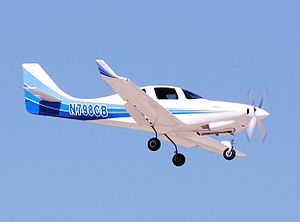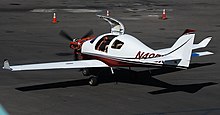Lancair IV
| Lancair IV | |
|---|---|

| |
| Lancair IV-P | |
| Role | Homebuilt aircraft |
| Manufacturer | Lancair |
| Status | Production completed 2012 |
| Produced | 360 (2011)[1] |
| Variants | |
The Lancair IV and IV-P are a family of four-seat, low-wing, retractable-gear, composite monoplanes powered by a 550-cubic-inch (9,000 cm3) Continental TSIO-550 twin-turbocharged piston engine.[1][2][3]
Production of the aircraft kit was ended in 2012.[4]
Development[edit]

The Lancair IV and IV-P were designed by Lancair around the Continental TSIO-550 — a twin turbocharged engine that is capable of developing 350 horsepower (260 kW) at sea level, and capable of operating at altitudes as high as 29,000 feet (8,800 m).[1][3]
By the fall of 2011, 110 Lancair IVs and 250 IV-Ps had been completed and were flying.[1]
In July 2016, the company announced it would sell the older Lancair lines of aircraft, including the Lancair IV, to concentrate on the Lancair Evolution instead. Once the transition was complete, the company changed its name to the Evolution Aircraft Company. The buyer of the old lines of aircraft continued in business as Lancair International, LLC.[5]
Operational history[edit]
In 2014, Bill Harrelson piloted a Lancair IV, and set a world speed record for solo flight between the earth's poles for an aircraft under 3,000 kilograms (6,600 lb) in a 175-hour-long series of flights. The flight also broke a record from Fairbanks, Alaska to Kinston, North Carolina. The aircraft was modified to hold 361 U.S. gallons (1,370 L; 301 imp gal) of fuel.[6]
Variants[edit]

- Lancair IV
- Unpressurized four seat kit-plane, powered by a 350 hp (261 kW) Continental TSIO-550 engine[1][3]
- Lancair IV-P
- Pressurized four seat kit-plane, powered by a 350 hp (261 kW) Continental TSIO-550 engine[1][3]
- Lancair Propjet
- Pressurized four seat kit-plane, powered by either a Walter or a PT6 Pratt & Whitney turboprop, that can achieve cruise speeds in excess of 300 knots (556 km/h) at altitudes up to 30,000 feet (9,140 m).
- Lancair Tigress
- A proposed pressurized version using the 600 hp (447 kW) Orenda OE600 V-8 engine, giving it a cruise speed of 405 mph (652 km/h). The engine was later cancelled, and consequently, only prototypes of the aircraft were completed.[7]
- RDD Enterprises LX7
- A re-manufactured version that converted an existing IV-P by replacing the wing with one with a new airfoil to reduce stall speed, a new fuel system, new interior, and avionics.[8]
Accidents[edit]
On November 11, 2023 a Lancair IV-P overran the runway at Aero Country Airport (T31) in McKinney, TX.
As of June 2014, the NTSB Aviation Accident Database recorded 20 crashes involving 18 fatalities across all IV variants.[9]
On February 3, 2012, Steve Appleton, CEO of Micron Technology, Inc., was killed while attempting an emergency landing in a Lancair IV-PT turboprop at the Boise Airport in Boise, Idaho, moments after takeoff. He had aborted a take off a few minutes earlier.[10][11]
Specifications (Lancair IV-P)[edit]
Data from Lancair website and AOPA[12][13]
General characteristics
- Crew: one
- Capacity: three passengers
- Length: 25 ft 0 in (7.62 m)
- Wingspan: 35 ft 6 in (10.82 m)
- Wing area: 98 sq ft (9.1 m2)
- Aspect ratio: 9:1
- Empty weight: 2,200 lb (998 kg)
- Gross weight: 3,550 lb (1,610 kg)
- Fuel capacity: 90 U.S. gallons (340 L; 75 imp gal), 110 U.S. gallons (420 L; 92 imp gal) with extended tanks
- Powerplant: 1 × Continental TSIO-550 six cylinder, horizontally opposed piston engine, 350 hp (260 kW)
- Propellers: 3-bladed Hartzell PHC-H3YF-1RF, constant speed, 12 ft 8 in (1.93 m) diameter
Performance
- Maximum speed: 342 mph (550 km/h, 297 kn)
- Cruise speed: 335 mph (539 km/h, 291 kn) @ 75% power, at 24,000 feet
- Stall speed: 71 mph (115 km/h, 62 kn) in landing configuration
- Range: 1,250 mi (2,010 km, 1,090 nmi) with 45 minute reserve at 24,000 feet
- Endurance: 4.3 hours with 45 minute reserve
- g limits: +4.4/-2.2 (utility category), +3.8/-2.0 (normal category)
- Rate of climb: 3,000 ft/min (15 m/s) at 3550 lbs gross weight
- Wing loading: 36.2 lb/sq ft (177 kg/m2) without winglets
References[edit]
- ^ a b c d e f Vandermeullen, Richard: 2011 Kit Aircraft Buyer's Guide, Kitplanes, Volume 28, Number 12, December 2011, page 59. Belvoir Publications. ISSN 0891-1851
- ^ Kitplanes Staff: 2008 Kit Aircraft Directory, page 59, Kitplanes Magazine December 2007 Volume 24, Number 12, Belvior Publications, Aviation Publishing Group LLC.
- ^ a b c d Bayerl, Robby; Martin Berkemeier; et al: World Directory of Leisure Aviation 2011-12, page 106. WDLA UK, Lancaster UK, 2011. ISSN 1368-485X
- ^ Lancair (2012). "Our Aircraft". Retrieved 15 November 2012.
- ^ "Lancair To Sell Legacy Assets In Favor Of Evolution Series - AVweb flash Article". avweb.com. Retrieved 30 July 2016.
- ^ Dan Namowitz, Dave Hirschman (March 2015). "Over the poles". AOPA Pilot: 43.
- ^ Purdy, Don: AeroCrafter - Homebuilt Aircraft Sourcebook, Fifth Edition, page 190. BAI Communications, 15 July 1998. ISBN 0-9636409-4-1
- ^ Cook, Marc (23 July 2019). "LX7: A Thoroughly Reworked Lancair IV-P". AVweb. Archived from the original on 25 July 2019. Retrieved 15 July 2019.
- ^ "Accident Database & Synopses". National Transportation Safety Board. Retrieved 19 March 2010.
- ^ "Steve Appleton, CEO of Micron, dies in airplane crash at Boise Airport". Idaho Statesman. 3 February 2012.
- ^ "CEO of chip maker Micron dies in plane crash". CBS News. 3 February 2012.
- ^ Lancair IV-P Specifications
- ^ "Lancair IV-P". www.aopa.org. 6 May 1994. Retrieved 8 July 2017.
